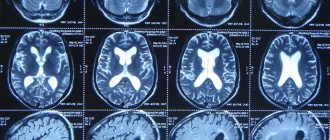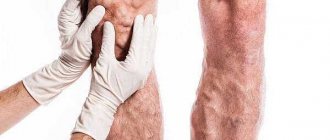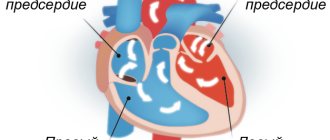Causes of pain in the heart and head
The main signs of cardiac dysfunction are pain in the chest, in the ribs, as well as shortness of breath, sweating, rapid heartbeat and arrhythmias, and a sharp deterioration in well-being. These symptoms may indicate acute or chronic heart disease. However, it is important to distinguish some diseases from heart failure. They also cause pain in the heart area, but are associated with pathologies of other organs.
Inflammatory heart diseases
Inflammatory heart diseases are often of infectious origin. Some viruses (adenoviruses, enteroviruses, herpesviruses, cytomegaloviruses and others, as well as their combinations) multiply in the tissues of the heart and cause severe pain. The process can also be caused by allergic reactions, autoimmune processes, accumulation of poisons and toxins in the body. During diagnosis, the nature of the inflammation and its exact localization, as well as other disorders caused by diseases, are determined.
- Myocarditis is inflammation of the myocardium, the heart muscle. This is a dangerous condition that manifests itself as sharp pain in the heart area. They occur at any time of the day, regardless of physical activity.
- Pericarditis is inflammation of the pericardium, the lining of the heart. The main symptom is severe, aching pain in the central part of the chest; sensations can radiate to the neck, back, and upper limbs. First, dry pericarditis develops, in which inflammation occurs without the formation of effusion. It is accompanied by a general deterioration in health, soreness and a dry cough. Then a more dangerous form may develop - effusion pericarditis. The pericardial cavity fills with fluid, which negatively affects blood circulation and can lead to dangerous consequences.
For pericarditis and myocarditis, taking nitroglycerin does not provide relief. This is the first sign that requires urgent medical attention. Inflammatory heart diseases lead to acute cardiac dysfunction and require treatment in a hospital setting.
Cardiac ischemia
Coronary heart disease is a common disease that occurs when there is insufficient blood supply to the myocardium. Due to damage or disease of the coronary arteries, the heart receives less oxygen than is necessary for its normal functioning. The heart muscle constantly works under increased load, which leads to a gradual decrease in its strength and elasticity.
One of the signs of exacerbation of coronary heart disease is an attack of angina. It lasts no more than 5 minutes, but is accompanied by a very vivid clinical picture. A person exhibits the following disorders:
- sharp, squeezing pain behind the sternum, which can radiate to the arm or back;
- a sharp deterioration in health, weakness, nausea, headache;
- rapid heartbeat, increased sweating;
- feeling of fear.
During an attack of angina, you must take nitroglycerin. It helps normalize heart function and relieves pain. It is also important to give up physical activity and bad habits until complete recovery - they can provoke another manifestation of angina pectoris.
Myocardial infarction
Myocardial infarction is one of the complicated forms of coronary heart disease. It is caused by partial or complete cessation of blood supply to a separate area of the myocardium, which leads to its necrosis. This is a dangerous condition that threatens the patient's life and requires emergency medical attention. A person experiences acute pain in the heart area, but it can also have an atypical location. Thus, many patients experience pain in the back, neck, upper limbs or head. A heart attack may be accompanied by symptoms of heart failure, including a dry cough, tachycardia, arrhythmia, and the appearance of sticky sweat.
Diagnostics is necessary to determine the cause of myocardial infarction and the degree of its danger to the patient. It can be caused by the following pathologies:
- atherosclerosis of the coronary arteries - a disease that leads to the deposition of cholesterol and some fractions of lipoproteins on the vascular walls, as well as the formation of plaques and blood clots;
- consequences of surgical intervention - some patients require ligation of the artery or its excision;
- embolus, which partially or completely blocks the lumen of the artery - gas, fat, thromboembolism and others are distinguished;
- a sharp spasm of blood vessels, which leads to blocking the access of blood to the myocardium.
At the first signs of a heart attack, you should immediately seek medical help. If the blood pressure is normal or low, the patient can be given aspirin to chew. Nitroglycerin is taken only in cases of high blood pressure. Until doctors arrive, the person must remain in a sitting position and loosen tight clothing, cuffs and collars. The hospital provides complex therapy aimed at relieving pain, resolving blood clots, improving the condition of the coronary arteries and restoring blood supply to the myocardium.
Other heart diseases
During diagnosis, various heart diseases may be detected, which cause sharp pain in the chest and head. Among them there are congenital and acquired pathologies, metabolic disorders, and consequences of an unhealthy lifestyle. Each disease of the cardiovascular system requires an individual approach to treatment.
- Arrhythmias are a common disorder that can have a number of manifestations. Its forms include tachycardia, bradycardia, and uneven heart rhythm. To normalize heart function, a therapeutic diet, moderate physical activity and medication are recommended.
- Heart defects are often congenital disorders. They are associated with abnormal structure of the heart valve apparatus or important vessels. The danger of defects is that they may not cause any symptoms for a long time. However, stress, irregular rest, and intense physical activity lead to acute chest pain and cardiac dysfunction.
- Pulmonary embolism is a serious condition that threatens human life. It manifests itself with symptoms similar to a heart attack. The pain is concentrated in the chest area and intensifies during inspiration. Taking nitroglycerin does not lead to improvement in well-being, so urgent hospitalization is necessary.
Doctors recommend undergoing routine examinations, which also include diagnosing heart conditions. Many diseases do not cause alarming symptoms in the initial stages, but in the future they can progress and threaten the patient’s life. Pain in the area of the heart and head, even if it quickly goes away on its own, is one of the signs for which it is important to obtain timely consultation with a cardiologist.
Non-cardiac diseases
Despite the fact that pain in the heart area clearly indicates pathologies of this particular organ, it can also be associated with other disorders. Thus, an attack of angina is often confused with intercostal neuralgia, due to the high intensity of pain and similar localization. There are several diseases in which a similar clinical picture appears, but their cause will be pathologies of other organs.
- Osteochondrosis of the thoracic spine is a chronic disease associated with a decrease in the strength of the intervertebral discs. Narrowing of the intervertebral space is the reason why neighboring vertebrae put pressure on nerves and blood vessels. This leads to acute pain concentrated behind the sternum, as well as numbness in the left or both arms.
- Intercostal neuralgia is pain caused by inflammation or mechanical compression of the intercostal nerves. Despite the similarity of symptoms, there are also differences with angina pectoris. Thus, with intercostal neuralgia, the pain intensifies during deep breaths, sudden turns and movements. Also, a person can accurately point to the painful area, but with angina, the pain spreads to the entire chest.
- Diseases of the central nervous system are the cause of pain in the heart, numbness of the upper extremities, shortness of breath, coughing, sweating and other typical symptoms of acute cardiac dysfunction. However, no changes are detected on the cardiogram, which may indicate a neurotic state.
- Lung diseases are another cause of pain in the heart and head. They appear with pneumonia, pleurisy. However, the pain intensifies only during inspiration and is often accompanied by fever and other typical symptoms.
It is impossible to determine the exact reason why your head and heart hurt at home. In addition, many patients experience fear when discomfort appears in the chest area, which makes it difficult to objectively assess the general condition. Only a complete examination will help determine what caused the pain, as well as select effective treatment.
Causes of pulsation of blood vessels in the head
The causes of pulsation in the head are extremely varied. Among them are those diseases that older people are more susceptible to, and those that occur in young people, being asymptomatic for the time being. Based on the nature of vascular pulsation, it is impossible to determine the exact cause of this symptom. After a conversation with the patient and a simple examination, a specialist can only suggest the pathology that provokes vascular disorders, and additional instrumental examinations will help clarify it.
Pulsation in the head accompanies diseases such as:
- Autonomic dysfunction (vegetative-vascular dystonia (VSD);
- Degenerative changes in the cervical spine - hernias, osteochondrosis, instability, congenital developmental features;
- Damages of the vascular wall - atherosclerosis, vasculitis;
- Aneurysm, vascular malformation;
- Neoplasms of the head and neck;
- ENT pathology;
- Glaucoma, incorrectly selected glasses;
- Suffered traumatic brain injuries;
- Neuroses, neurasthenia and other psychiatric problems.
Arterial hypertension is one of the most common causes of pulsation in the head.
This disease is also very common among mature and elderly people, for whom pulsation in the head is a well-known symptom.
Hypertension primarily affects the arteries and arterioles, which become spasmed due to constant high pressure, resulting in impaired blood flow in the brain. Against the background of a sharp rise in pressure - a crisis - the patient feels pulsation in the temples, pain in the back of the head, possibly dizziness and tinnitus. The higher the pressure number, the more obvious and painful the pulsating feeling, but as the pressure readings drop to normal, the symptoms gradually disappear.
Autonomic dysfunction is common among young adults, children and adolescents.
More often, females suffer from the disorder, and the regulation of vascular tone by the autonomic nervous system is disrupted, resulting in fluctuations in systolic pressure, pulse, and it is quite possible that a pulsating feeling may occur even in the throat.
Pulsation against the background of autonomic dysfunction is provoked by stress, emotional experiences, physical overload and fatigue. Smoking and alcohol abuse have a negative impact.
Ripple with VSD occurs without pain, but is often accompanied by other signs of autonomic disorder - sweating, redness of the face, discomfort and rumbling in the abdomen, cardialgia, a feeling of shortness of breath with increased breathing, weakness and decreased performance, low-grade fever. Mood swings and panic attacks are also characteristic, which often help diagnose the cause of the pulsation.
Degenerative changes in the spine can be detected in almost every second adult inhabitant of the planet.
Such a wide spread of pathology is facilitated by a sedentary lifestyle, sedentary work, and excess weight. Disc herniations, developmental abnormalities of the bony processes of the vertebrae, and osteochondrosis cause compression of blood vessels and nerves, resulting in pain and pulsation in the back of the head and parietal regions. The pulsations are accompanied by numbness in the limbs, neck pain, and fluctuations in blood pressure.
cerebral atherosclerosis
Structural changes in vascular walls
in the form of atherosclerosis, inflammation (vasculitis) can cause narrowing of their lumen and hemodynamic disturbances. When an artery is half stenotic by an atherosclerotic plaque, the brain begins to experience hypoxia even with the active functioning of collateral blood flow pathways. Patients with atherosclerosis of the arteries of the head complain not only of a feeling of pulsation, but also of noise, ringing in the ears and head, decreased memory and mental performance, they are prone to depression and apathy.
Inflammation of the vascular wall is called arteritis. It can be a consequence of an autoimmune disease, injury, surgery, or infectious disease. In the acute period of vasculitis, pulsation occurs with intense headache, general weakness, and possibly anxiety.
An extremely dangerous cause of pulsation of the vessels of the head is considered to be an aneurysm or arteriovenous malformation. An aneurysm is a tangle of pathologically developed vessels that can be located in any part of the brain. Arteriovenous malformation is an interweaving of arterial and venous dysplastic vessels. These formations are almost always congenital in nature, are asymptomatic for a long time and can manifest as periodic throbbing pain in a certain part of the head - in the temples, back of the head, crown of the head.
Since vascular anomalies are accompanied by a violation of the structure of the walls of the vessels that form them, under certain conditions their rupture can occur - during a pressure surge, injury, or severe stress. Rupture of blood vessels results in hemorrhage into the substance of the brain or under its membranes, which is often fatal.
The feeling of pulsation depends on the size of the aneurysm - the larger it is, the more clearly the patient feels the pulsation. Small aneurysms may not cause pain, but the pulsating symptoms are usually bothersome. In addition to pulsation, other signs of malformation are possible: noise in the head, memory loss, anxiety, and with large aneurysms - seizures.
New growths in the head and neck can also contribute to unpleasant, palpable throbbing.
They occur much less frequently than hypertension, atherosclerosis or osteochondrosis, but often affect children and young people. In addition to pulsation, tumors cause pain, dizziness, with an increase in intracranial pressure, nausea and vomiting that does not bring relief are added, convulsions and other neurological symptoms are possible - decreased vision, paralysis of the limbs, coma, etc.
Ripple without other symptoms can accompany small neoplasias, which put pressure on the vessels from outside and impede the flow of blood through them. More often it appears in the morning and increases as the tumor grows. Pulsation in the head may be one of the first symptoms of tumor growth.
Inflammatory processes of the ENT organs,
accompanied by the accumulation of exudate there, can manifest themselves as pulsating sensations in the head, a feeling of fluid transfusion from the side of the affected ear. In addition, patients are bothered by headaches, noise, whistling in the head, and progressive hearing loss.
Glaucoma
, incorrectly selected glasses or refusal of them due to insufficient visual acuity create not only negative sensations in the eyes, provoke even greater vision problems, dizziness and a feeling of lightheadedness, but can also cause pulsation in the temples and frontal area.
This pulsation becomes more noticeable with an increase in intraocular pressure, eye strain when working with a computer, reading, and is accompanied by a headache.
Pulsation in the head in some cases accompanies traumatic brain injuries.
In the acute phase, it is combined with severe headache, vomiting, convulsions, and in severe cases, consciousness is also impaired. The consequence of the injury can be periodically recurring attacks of pain and throbbing in the head.
Various neurotic disorders, schizophrenia and other psychiatric diseases
often occur with pulsation in the head, which the patient can describe very colorfully, clearly defining the location of its localization, which can complicate diagnosis, because it is quite difficult to check whether the patient is telling the truth.
Neurasthenia is a borderline disorder that is provoked by stress, overwork, improper work and rest patterns, and individual characteristics of emotional response. Chronic tension of the nervous system sooner or later leads to its exhaustion, and a person turns into a neurasthenic patient who complains of constant fatigue, insomnia or drowsiness, irritability, decreased appetite and bad mood. In addition to these complaints, pulsation in the head, pain, noise, which intensifies against the background of emotional experiences, are also characteristic.
In the case of schizophrenia and other psychotic disorders, the situation is more complicated: unclear pulsations and noise may be part of the hallucinations that the patient experiences, and in addition to a vivid description of symptoms, the doctor is often faced with their exaggeration, which significantly complicates an objective assessment of symptoms.
Diagnostic methods
After the examination, the doctor will prescribe an examination regimen to assess the patient’s general condition and to understand the cause of pain in the heart area. It will include only those techniques that allow you to determine the cause of deterioration in health:
- blood tests - include general and biochemical studies, as well as determination of the level of cholesterol, lipids and other specific elements;
- ECG (electrocardiography) is a method of assessing the work of the heart, which consists of recording electric fields, can be carried out within a few minutes or 24 hours;
- Cardiac ultrasound is an informative diagnostic method that allows you to identify heart defects, anomalies in the structure of valves and large vessels;
- Ultrasound of vessels with the addition of a contrast agent - prescribed to assess the speed and intensity of blood circulation, the presence of blood clots;
- other methods - may include examination of the cervical spine, diagnostic tests, ultrasound of internal organs, fluorography.
At the Clinical Brain Institute, you can undergo a complete diagnosis if pain occurs in the head and heart. Modern equipment is located here, thanks to which it is possible to obtain accurate results in a short time. In addition, patients are offered comfortable conditions for placement in a hospital for the period of examination and manipulation.
Causes of rheumatism
Why do some people get rheumatism, while others under the same conditions do not? People who often suffer from ENT diseases are more likely to get rheumatism. Those at risk are those whose relatives have this disease and those who have the B-cell marker D8/17 in their blood.
So, the risk factors:
- streptococcal infection (angina, scarlet fever, pharyngitis);
- defects of the immune system, the presence of autoimmunity;
- genetic predisposition to the disease.
Treatment methods
If you experience sharp pain in your heart, you must take a sitting position and unfasten your collar and cuffs. If your blood pressure is elevated and you suspect an angina attack, you should take a nitroglycerin tablet. It is also important to provide access to fresh air into the room. If symptoms do not go away after 15–30 minutes, you need to call an ambulance.
The treatment regimen is selected individually, depending on the exact diagnosis, the patient’s age and other factors. During an exacerbation of diseases, hospital treatment may be necessary, but then it is necessary to follow doctors’ orders at home. Thus, the treatment regimen may include the following steps:
- taking medications - prescribed individually, necessary for long-term use for certain diseases;
- proper nutrition - to reduce the load on the heart, you need to avoid fatty and salty foods;
- surgery - is prescribed only if there is a threat to life due to a blood clot or heart defects.
At the Clinical Brain Institute, treatment is carried out both in an inpatient and outpatient setting. At the center you can receive 24-hour medical supervision, as well as recommendations for doing it at home. The effectiveness of treatment depends on the timely use of medications, as well as proper nutrition and other factors.
What to do if you have heart pain?
Of course, consult a doctor! Don’t wait for a miracle, but make an appointment with a cardiologist and neurologist as soon as possible. If you have constant pain in the heart - dull, pulling, aching - you need to undergo an examination to identify cardiac pathologies.
If the pain is sharp, acute, sudden, accompanied by pallor of the skin, sweating, weakness, a feeling of suffocation or fainting, then it is necessary to urgently call an ambulance. This set of symptoms can be either a panic attack or a heart attack or myocardial infarction.
Be a friend to your heart - undergo annual examinations, maintain optimal weight, take medications strictly as prescribed by your doctor and lead a healthy lifestyle!
Be healthy!
Prevention methods
Most diseases that cause pain in the head and heart can be prevented. To do this, it is enough to follow a set of simple rules recommended by cardiologists around the world:
- give up bad habits - smoking and drinking alcohol are dangerous for the heart and have a detrimental effect on the condition of blood vessels;
- eat right, avoid excess fat, salt and sugar in the diet;
- lead an active lifestyle - moderate physical activity improves the condition of the myocardium and strengthens the vascular walls.
The Clinical Brain Institute specializes in the diagnosis and treatment of diseases that cause pain and discomfort in the head and heart. Our center has all the conditions for conducting examinations of various levels of complexity, as well as for treatment and rehabilitation. Specialist and generalist doctors are specialists with many years of experience. However, it is important to seek medical help promptly, since the effectiveness of treatment decreases as the disease worsens.
Diagnosis of rheumatism
When diagnosing the disease, the following methods are used:
- ECG;
- Ultrasound of the heart;
- X-ray examination (helps to see changes in the size and shape of the heart);
- general blood test (can show ESR level, anemia, etc.);
- immunological blood test (appearance of C-reactive protein, presence of streptococcal infection).
1 General blood test
2 Immunological blood test
3 Diagnostics of rheumatism in MedicCity










